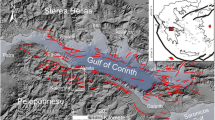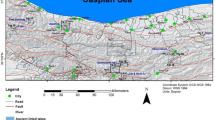Abstract
Seimareh Landslide (SL) is globally recognized as one of the largest rock mass movements in the world. It is located along the border of Ilam and Lorestan provinces in southwest Iran, in the heart of the Zagros Mountain Range. There are controversial findings about the mechanism of the landslide formation. This field work study reviewed the possible mechanisms of failure and analyzed post-failure geomorphic features. Drainage pattern disturbance in the depositional region and consequent dammed lake formation are among the most significant characteristics of these features. Seimareh, Jaidar and Balmak are three large landslide-dammed lakes. The present study analyzed the processes responsible for the formation and erosion of the Jaidar and Seimareh Landslide dams using the available annual sedimentation and field measurements of the sediment deposited in these lakes. The results showed that the SL dam has been formed about 935 years after the landslide event. Detailed field investigations indicated a specific hydro-morphological condition in the landslide area. The results implied that the main causes of the failure were probably the particular hydro-morphological characteristic of the landslide source area together with the enormous eroding energy resulted from merging of two high-flow rivers which eroded the base of the southern flank of Kabir-kuh Mountain. However, the unusual size of the landslide suggests that an external factor, e.g., a huge earthquake, might have triggered the failure.






Similar content being viewed by others
References
Aghanabati A (2004) Geology of Iran. Geological Survey of Iran Press, 586 pages
Ambraseys NN, Melville CP (1982) A history of Persian earthquakes. Cambridge University Press, London
Banihabib ME, Shoaei Z (2000) A model for seizing of debris deposition in Seimareh area. In: 4th international conference on hydro-science and engineering, pp 1–8. http://kfki.baw.de/conference/ICHE/2000/Soul/html
Berberian M (1994) Natural hazards and the first earthquake catalogue of Iran, historical hazards in Iran prior to 1900, vol 1. International Institute of Earthquake Engineering and Seismology (IIEES) Press, Iran
Cruden DM, Varnes DJ (1996) Landslides types and processes. In: Turner AK, Schuster RL (eds) Landslides: investigation and mitigation. Transportation research board special report 247. National Academy Press, Australia, pp 36–75
FRWMOI (2002) Forest, rangeland and watershed management organization of Iran landslide data bank of Iran. Project report (in Persian)
Harrison JV, Falcon NL (1937) The Saidmarreh landslip, Southwest Iran. Geogr J 89:42–47
Harrison JV, Falcon NL (1938) An ancient landslip at Saidmarreh in southwestern Iran. J Geol 46:296–309
Harrison JV, Falcon NL, Mailing APB (1935) The geology of Lorestan from a reconnaissance. NIOC report No. 490
Hsu KJ (1975) Catastrophic debris stream (sturzstorm) generated by rock falls. Bull Geol Soc Am 86(1):140–1299
Huchinson JN (1988) General report, morphological and geotechnical parameters in relation to geology and hydrogeology. In: Proceedings of the 5th international symposium on landslides, Lausanne, vol 1, pp 3–36
Mahr T (1977) Deep-reaching gravitational deformations of high mountain slopes. Bull Int Assoc Eng Geol 16:121–127
Nicoletti PG, Parise M (1996) Geomorphology and kinematics of the Conturrana rockslide-debris flow (NW Sicily). Earth Surf Process Landf 21:875–892
Nicoletti PG, Parise M, Miccadei E (1993) The Scanno rock avalanche (Abruzzi, south-central Italy). Bollettino della Società Geologica Italiana 112:523–535
NIOC (1970) National Iranian Operating Oil Company, Geological and exploration division. 1/100000 Geological map of western Iran maps. Tehran, Iran
Oberlander T (1965) The Zagros stream: a new interpretation of transverse drainage in an organic zone., Syracuse geography serSyracuse Univ. Press, USA
Parise M, Guzzi R (1992) Volume and shape of the active and inactive parts of the Slumgullion Landslide, Hinsdale County, Colorado. US Geological Survey Open-File Report 92–216, p 29
Radbruch Hall DH (1978) Gravitational creep of rock masses on slopes. In: Voight B (ed) Rockslides and avalanches, 1. Natural phenomena. Developments in geotechnical engineering 14A. Elsevier, UK, pp 607–657
Radbruch Hall DH, Varnes DJ, Savage WZ (1976) Gravitational spreading of steep-sided ridges (“sackung”) in western United States. Bull Int Assoc Eng Geol 14:23–35
Saghafian B, Ghermezcheshmeh B, Samiee M (2007) Regional sediment analysis of South-Western basin of Iran, Technical Report. Water Research Institute, Ministry of Energy, Iran (in Persian)
Scheidegger AE (1973) On the prediction of the reach and velocity of catastrophic landslides. Rock Mech 5:231–236
Schuster RL (1991) Landslides—analysis and control—special report 176. In: Schuster RL, Krizek RJ (eds) TRB, National Research Council, Washington, Chap. 3, pp 36–71
Shayan S (1994) Geomorphologic evidences for dating the occurrence of largest landslide in Kabir-kuh, Zagros. West Iran J Humanit 13(1):71–91
Shoaei Z, J Ghayoumian (1998) Seimareh Landslide, the largest complex slide in the world. In: Proceedings of the eighth international congress, international association for engineering geology and the environment, IAEG, Vancouver, vol II, pp 1337–1342
Shoaei Z, Ghayoumian J (2000) Seimareh Landslide, Western Iran; one of the world’s largest complex landslides. Landslide News 13:23–27
Shoaei Z, SR Emamjomeh, GR Shoaei, M Shariatjafari (2006) Application of engineering geology parameters to improvement scrutinizing of landslide zonation methods. In: IAEG congress 6–10 September, University of Nottingham
Souri M, Shoaei Z, Jalali N, Zare M (2009) Investigation on structural control type of landslide in Central Zagros, Western Iran. In: 27th earth science conference, Iran (in Persian)
Varnes DJ (1978) Slope movement types and processes. In: Schuster RL, Kriezek RJ (eds) Landslide analysis and control. Transportation Research Board, National Academy of Sciences, Washington, Report 176, pp 11–33
Watson RA, Wright HE (1969) The Saidmarreh Landslide, Iran. In: Geol Soc. American Special paper, No. 123, pp 115–139
Acknowledgments
This study is a part of the International Program on Landslides (IPL M-114) of the International Consortium on Landslides (ICL). The author would like to extend his appreciation to the field work team consisting of Farhadi, A. and Karam Soltani, for their efforts and scientific contributions. This work was largely supported by Soil Conservation and Watershed Management Research Institute (SCWMRI), Ministry of Jihad-e-Agriculture, Iran. The helpful manuscript reviews by Stephen G. Evans, A. Ghafouri and G.H. Shoaei, are greatly appreciated.
Author information
Authors and Affiliations
Corresponding author
Rights and permissions
About this article
Cite this article
Shoaei, Z. Mechanism of the giant Seimareh Landslide, Iran, and the longevity of its landslide dams. Environ Earth Sci 72, 2411–2422 (2014). https://doi.org/10.1007/s12665-014-3150-8
Received:
Accepted:
Published:
Issue Date:
DOI: https://doi.org/10.1007/s12665-014-3150-8




